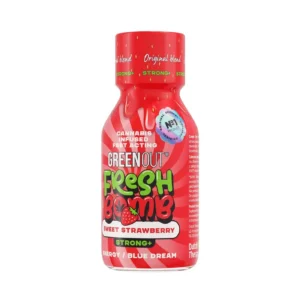Genetics and variety selection
The genetics of a cannabis plant play a key role in determining its potency. Different strains naturally have different levels of THC due to their genetics. Breeders have selected strains with extremely high THC levels, such as Jenny Kush, which can contain up to 42% of THC, making it one of the most potent available [1]. Other notable strains with high THC levels include Godfather OG, Alien Mints and Dulce. It's worth remembering, however, that while genetics determine THC production potential, actual levels can vary depending on growing conditions and other factors.
Growing conditions
The environment in which hemp is grown significantly affects its potency. Key growing conditions include:
- Light intensity: Adequate lighting is crucial for THC production. Higher light levels can increase THC levels, but there is a limit beyond which additional light does not increase potency.
- Fertilization: Proper fertilization is essential, but over-fertilization can lead to cannabinoid dilution effects, where greater plant growth results in lower THC concentrations per gram of flower.
- Temperature and humidity: Maintaining optimal levels of temperature and humidity helps maximize THC production. Extreme conditions can stress the plant and potentially reduce potency.
- Drought stress: Some studies suggest that controlled drought stress can increase THCA (THC precursor) levels by as much as 12%, but the technique is advanced and comes with risks.
Harvest time
Determining the right time to harvest is key to achieving maximum potency. Cannabis plants should be harvested when the trichomes - small, crystalline structures on the buds - reach their highest THC concentration. This usually happens when the trichomes turn cloudy or milky white. Harvesting too early or too late can result in lower THC levels, as THC can degrade to less psychoactive compounds, such as CBN, over time [2].
Processing and storage
After harvesting, proper processing and storage are essential to preserve the power of marijuana:
- Drying: The buds should be dried slowly in a controlled environment to prevent mold growth and preserve cannabinoids.
- Curing (ripening): Ripening involves storing the dried buds in airtight containers and periodically opening them to release moisture, allowing for even ripening and flavor development.
- Storage: Cannabis should be stored in a cool, dark place to protect it from light and heat, which can degrade THC.
Terpenes and their effects
Terpenes are aromatic compounds found in cannabis that give it its characteristic smell and taste. They also play a role in modifying the effects of THC through ambient effects. Some common terpenes are:
- Mircen: Often found in indica varieties, it has calming and relaxing properties.
- Limonene: Typical of sativa varieties, associated with an uplifting and mood-enhancing effect.
- Cariophilene: It has anti-inflammatory and analgesic properties and can interact with cannabinoid receptors.
- Pinene: Known to promote alertness and memory retention, it also has anti-inflammatory benefits [3].
The combination of terpenes and cannabinoids can create a unique experience for each variety, affecting the perception of potency.
Consumption methods
How marijuana is consumed affects how THC is absorbed and experienced:
- Smoking/Vaping: These methods provide rapid onset of effects within minutes, with peak effects around 30 minutes and lasting 1-3 hours. They allow easy control of the dose.
- Edibles (food): Edibles have a delayed onset, usually taking 30-90 minutes, with effects lasting 4-8 hours or more. The liver converts THC into 11-hydroxy-THC, a more potent form, leading to stronger and longer lasting effects [4].
- Topicals (cosmetics): Applied to the skin, they provide localized relief without psychoactive effects.
Each method has its own advantages and is adapted to different preferences and situations.
Ambient effect
The ambient effect is a theory suggesting that various compounds in cannabis, including cannabinoids and terpenes, work synergistically to create a greater effect than any single compound on its own. This concept suggests that full-spectrum cannabis products may offer enhanced therapeutic benefits compared to products containing isolated THC or CBD. While research is ongoing, many users report better experiences with whole plant products, supporting the idea of an ambient effect.
The potency of marijuana is the result of a complex interaction of many factors, from the genetics of the strain to the conditions under which it is grown, harvested, processed and consumed. In addition, the presence of terpenes and other compounds can modify the effects of THC, contributing to the overall experience. By understanding these factors, users can make more informed decisions about cannabis use, aligning their choices with the desired effects.
It is important to note that marijuana with high THC content may be associated with mental health risks, especially with frequent use, which is a topic of controversy. For example, research suggests a possible link to schizophrenia risk, but the data is inconclusive (Yale Medicine). Therefore, caution is advised, especially for new users.
Factors affecting the potency of marijuana
| Factor | Description | Examples or Data |
|---|---|---|
| Genetics | Different varieties have different levels of THC, determined genetically. | Jenny Kush (up to 42% THC), Godfather OG (>25% THC). |
| Growing conditions | Lighting, fertilization, water, temperature all affect THC production. | 12% increase in THCA with drought (Caplan et al 2017). |
| Harvest time | Harvesting at peak THC (cloudy trichomes) maximizes potency. | Harvesting too late degrades THC to CBN (Ferrer 2020). |
| Processing and storage | Drying, curing and storing in airtight containers preserve potency. | – |
| Terpenes and cannabinoids | Terpenes (myrcene, limonene) and CBD modify the effects of THC. | Mircenium calms, CBD relieves paranoia. |
| Consumption method | Smoking, vaping, edibles affect THC delivery. | Edibles produce effects for up to 8 hours [4]. |
| Individual factors | Tolerance, dose, body weight, metabolism, mood. | Interruptions reduce tolerance. |








